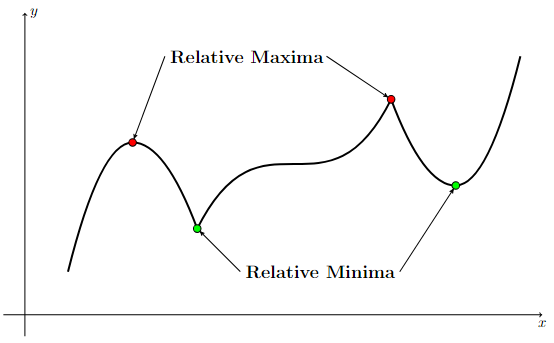Relative Extrema#
Definitions#
Definition
A function \(f\) has a relative maximum at \(x=c\) if there exists an open interval \((a,b)\) containing \(c\) such that \(f(c) \geq f(x)\) for all \(x\) in \((a,b)\). In this case, \(f(c)\) is called a relative maximum value of \(f\).
Definition
A function \(f\) has a relative minimum at \(x=c\) if there exists an open interval \((a,b)\) containing \(c\) such that \(f(c) \leq f(x)\) for all \(x\) in \((a,b)\). In this case, \(f(c)\) is called a relative minimum value of \(f\).
Example 1#
Relative Extrema
The relative extrema are highlighted on the following graph. Observe how the relative extrema appear at points on the curve where the increasing/decreasing behavior of the function changes. In other words, relative extrema appear at points on the graph of the function where the derivative changes sign.

Long Text Description
There is a horizontal x-axis. There is a vertical y-axis. The graph of a function is plotted on these axes. Moving from left to right, the function goes up towards a rounded corner, which is marked in red and labeled a relative maximum, then goes downward towards a sharp corner, which is marked in green and labeled a relative minimum, then goes up again towards another sharp corner, which is marked in red and labeled a relative maximum, then goes down again towards a rounded corner, which is marked in green and labeled a relative minimum, and then goes upward.
Observation About \(f'\) Where Relative Extrema Appear
The relative extrema of a function appear where \(f'(x)\) changes from positive to negative or from negative to positive. Since \(f'(x)\) changes sign when there is a relative extrema, it must be the case that either \(f'(x)=0\) or \(f'(x)\) does not exist at the relative extrema.
